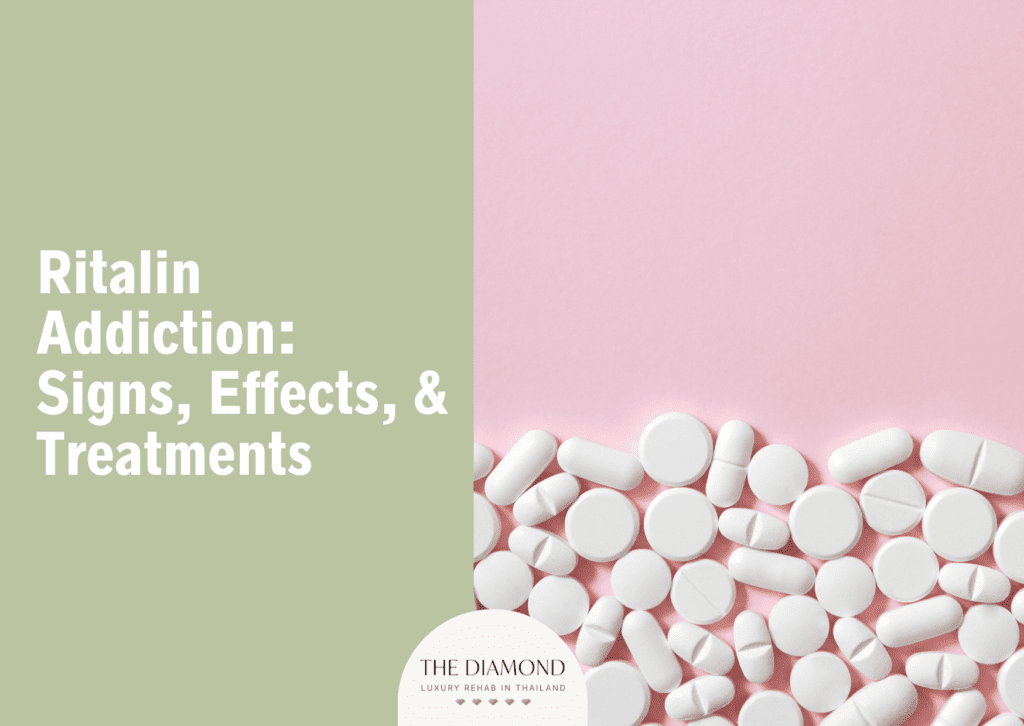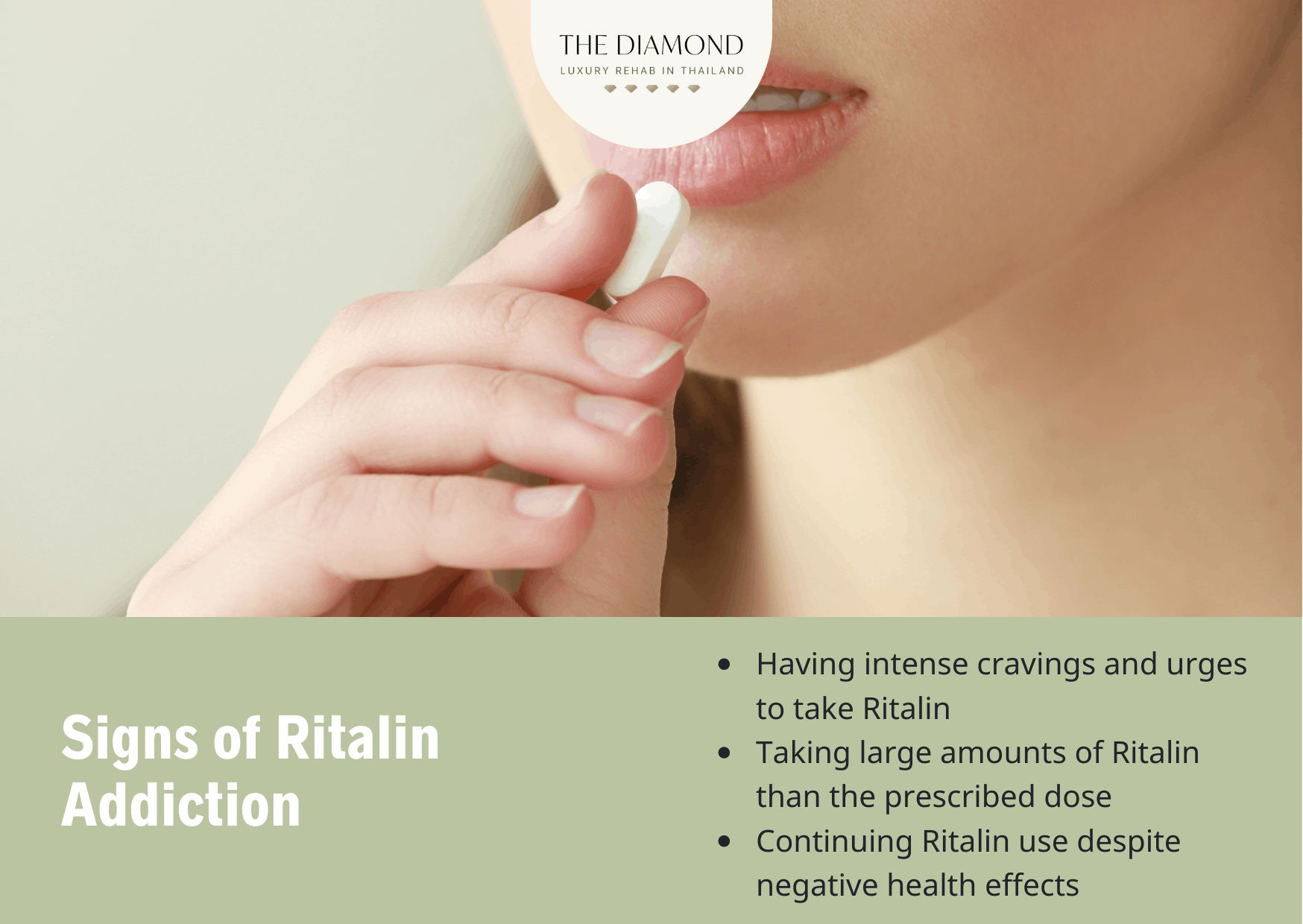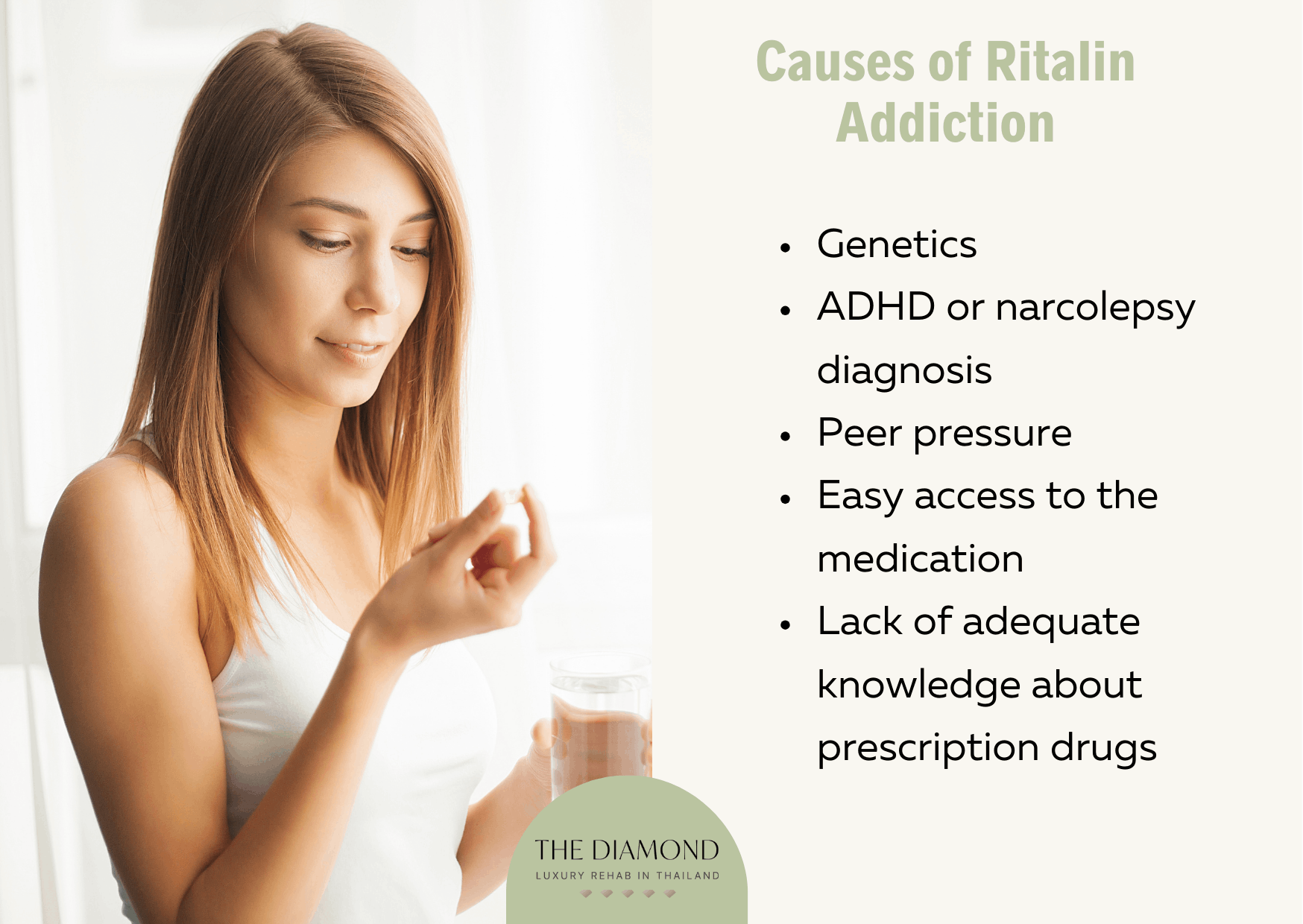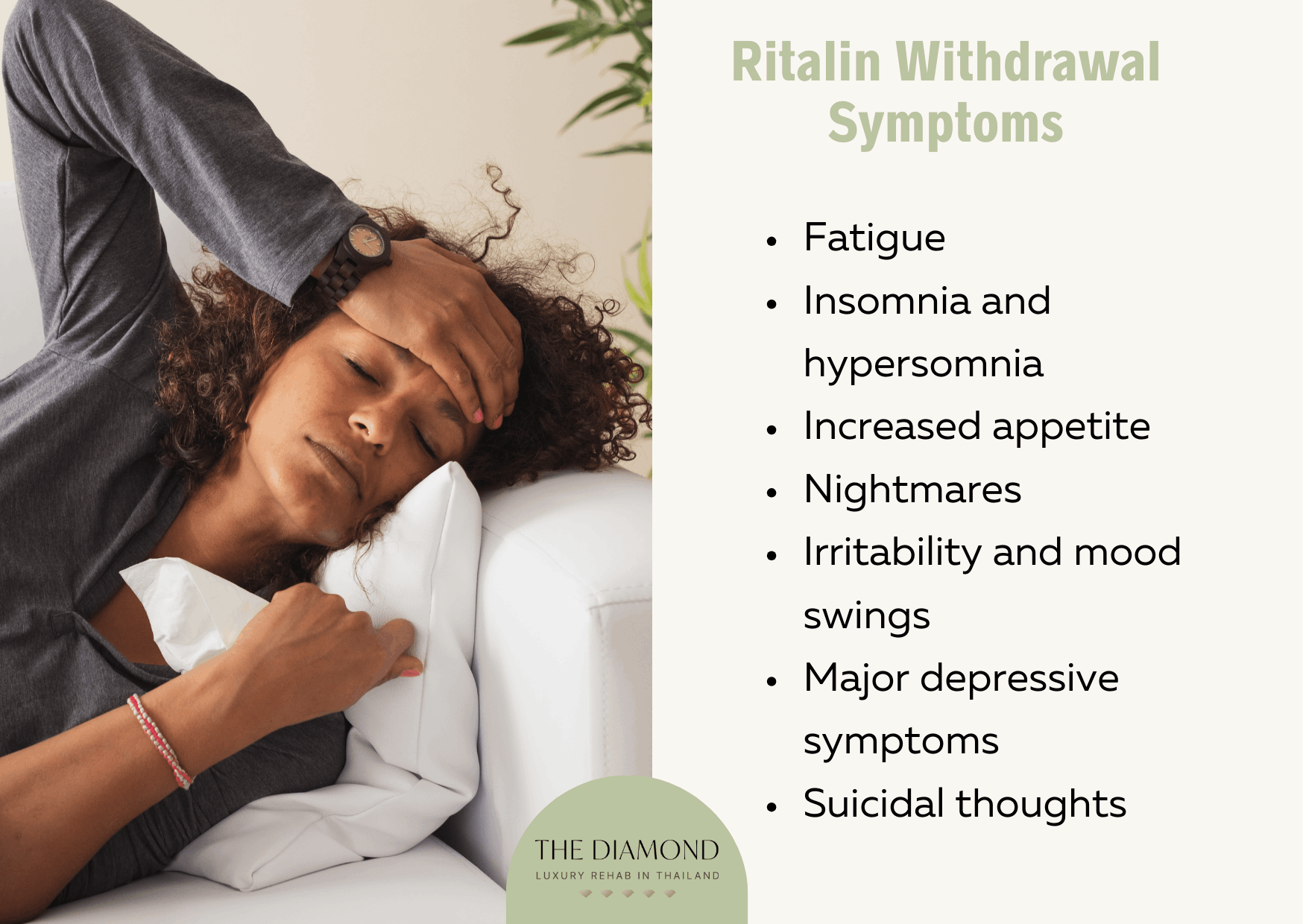Ritalin addiction: signs, effects, and treatments

Ritalin is a prescription medicine used to treat the symptoms of attention deficit hyperactivity disorder (ADHD). It is a popular brand name for methylphenidate, which belongs to a class of drugs called stimulants. As stimulants have the ability to excite any bodily function, it is normal to wonder and ask yourself: “Is Ritalin addictive?”
The signs of Ritalin addiction include intense urges to take the medicine, taking large amounts of Ritalin than the prescribed dose, spending a lot of time thinking about Ritalin, figuring out how to get it, or recovering from its effects, continuing Ritalin use despite negative health effects, and experiencing withdrawal symptoms when cutting back or stopping Ritalin use.
The effects of Ritalin addiction include low appetite, anxiety, altered heart rate, increased blood pressure, insomnia, fatigue, nervousness, panic attacks, and depression.
What is Ritalin addiction?
Ritalin addiction is a serious substance use problem that involves the recurrent use of the ADHD medication Ritalin despite negative consequences. As with other physical addictions, dependence on Ritalin results from prolonged abuse and can cause painful withdrawal symptoms once the use of the drug has been abruptly or gradually stopped.
What are the street names for Ritalin?
The street names for Ritalin are listed below.
- Kiddie coke: Ritalin is known as kiddie coke or kiddie cocaine because it is most frequently prescribed for children’s ADHD, and it is said to have similarities with cocaine when abused. Ritalin and cocaine are both stimulants that release large quantities of dopamine when used recreationally.
- Kibbles and bits: a term used to primarily refer to Ritalin, as stated by the National Drug Intelligence Center. The synonymous word for both drugs comes with little surprise, as Ritalin and cocaine have the same pharmacological profile and are abused for the stimulant effects they produce.
- Pineapple: Ritalin is also known by the code name “pineapple” on the streets. It is estimated that around four million American children and thousands in the United Kingdom engage in Ritalin abuse to help them stay awake in big exams.
- Vitamin R: Vitamin R stands for Ritalin, and it may have been called as such because of the increased alertness and improved energy it provides when used in inappropriate doses.
- Skippy: another popular street name for methylphenidate, which, despite being tightly controlled by regulating agencies, is relatively easy to get. Students who are prescribed the medication often sell it to their peers for a few dollars.
- R-ball: Ritalin is also sold in the illicit market as R-ball. According to data from IQVIA, formerly known as IMS Health, an estimated 11 million Ritalin prescriptions are given out each year. This means that there is plenty of the drug circulating in what has now become a black market distribution network at different schools.
What are the signs of Ritalin addiction?

Ritalin is abused for the stimulant effects they provide. Recognizing the indications of misuse are especially helpful for parents, so abuse can be avoided on their children’s part. The signs of Ritalin addiction are listed below.
- Having intense cravings and urges to take Ritalin: As prolonged use of Ritalin raises dopamine levels, the brain starts associating pleasurable feelings with the use of the substance. Over time, the changes in the brain caused by abnormal dopamine levels are going to affect your thoughts, emotions, and decision-making.
- Taking large amounts of Ritalin than the prescribed dose: Someone who develops an addiction to Ritalin will continue taking larger amounts of the medication than originally planned. This is done to get the same stimulant effects initially experienced with the medication.
- Spending a lot of time thinking about Ritalin, figuring out how to get it, and recovering from its effects: Ritalin abuse involves preoccupations with taking the medication. Eventually, someone’s life starts revolving around Ritalin use, and they may even steal or sell belongings to be able to afford the drug.
- Continuing Ritalin use despite negative health effects: One of the hallmarks of addiction is compulsive seeking and use of the drug despite negative effects on physical and mental health. This lack of self-control involving drug use occurs because of functional changes to the brain caused by addiction.
- Experiencing withdrawal symptoms when cutting back or stopping Ritalin use: When a Ritalin addict abruptly or gradually stops taking the medication which they have regularly consumed, their body finds it hard to adjust to the absence of Ritalin in their system. This results in unpleasant withdrawal symptoms, which is a major factor why people with substance use disorders stay trapped in the vicious cycle of addiction.
What are the possible causes of Ritalin addiction?

Recreational Ritalin use does not stem from a single factor. Instead, a combination of various factors influence one’s risk for addiction. The possible causes of Ritalin addiction are listed below.
- Genetics: Ritalin addiction may run in families. A study published in the U.S. Department of Health and Human Services (HHS) public access suggests that as much as half of a person’s susceptibility to prescription drug addiction can be linked to his or her genetic makeup.
- ADHD or narcolepsy diagnosis: While Ritalin is the mainstay treatment for attention deficit hyperactivity disorder (ADHD), it is only a second-line option for narcolepsy treatment. However, having either of the two conditions may increase someone’s risk of developing Ritalin addiction. Using the medication can become a way of self-medicating, which is not helpful and can even up their risk of becoming addicted to Ritalin.
- Peer pressure: Ritalin is also known on the streets as kiddie cocaine for a reason – young people using the medication as a party drug is on the rise, and some kids actually consider it cool to engage in addictive behaviors around Ritalin.
- Easy access to the medication: Not only are prescription drugs easier to get because family members or friends may have them, but they can also be sold on the streets like other illicit drugs. It is worth noting that medications are only safe for people who have prescriptions for them.
- Lack of adequate knowledge about prescription drugs: Effective drug education is particularly important for young people, who can easily be shaped by various influences to engage in licit and illicit substance use.
What are the side effects of Ritalin?
Abusing Ritalin through taking the medicine in a manner not prescribed by a healthcare professional may result in negative consequences. The side effects of Ritalin are demonstrated in the table below.
| Short-Term Effects | Long-Term Effects |
| Suppressed appetite | Unintentional weight loss, malnutrition |
| Increased heart rate | Fast or irregular heartbeats |
| Sleep disturbances | Insomnia |
| Agitation, irritability | Disorientation and apathy |
| Behavioral changes | Delusions, hallucinations, and other psychotic symptoms |
| Fatigue | Frequent seizure activity |
| Paranoia | Alternating manic and depressive episodes |
| Abdominal pain | Gastrointestinal disorders, including constipation and irritable bowel syndrome (IBS) |
| Lying to cover up addiction | Withdrawal from loved ones |
| Panic attacks | Depression |
How is Ritalin addiction being diagnosed?
Ritalin addiction can be diagnosed through a careful evaluation that often includes an assessment by a psychiatrist, psychologist, or an addiction counselor.
These licensed mental health professionals may use the criteria for substance use disorders stated in the Diagnostic and Statistical Manual of Mental Disorders (DSM-5) in order to diagnose Ritalin addiction.
What is the Ritalin addiction statistics?
According to a national survey of parents by the Centers for Disease Control and Prevention, the approximate number of children aged 3–17 years ever diagnosed with ADHD In the United States is 6 million for which the main treatment is a Ritalin prescription. Recent studies show that the fastest-growing drug problem in the country is that of prescription drugs, which profoundly affects teenagers’ lives.
In fact, in 2016, nearly 2 million young Americans aged 12 and above reported abusing prescription stimulants like Ritalin. Furthermore, the National Institute on Drug Abuse (NIDA)’s Monitoring the Future survey found that more than 50% of students who engaged in non-medical use of Ritalin and other prescription stimulants said they got them from family members or friends.
What are the Ritalin withdrawal symptoms?

Once the body gets used to Ritalin, it will depend on the medication to function normally, even if doing so adversely impacts a person’s wellbeing. That is why when a Ritalin addict attempts to cut down drug use suddenly or drastically, they tend to experience uncomfortable signs of withdrawal. The Ritalin withdrawal symptoms are listed below.
- Fatigue: Stimulants like Ritalin are known to increase alertness and energy, and taking too much of it can significantly increase your heart rate. Therefore, when a person stops taking Ritalin, the body starts to adjust with the absence of the substance and this results in low energy or fatigue.
- Insomnia and hypersomnia: Ritalin withdrawal has been associated with both insomnia and hypersomnia. While insomnia involves impairments related to difficulty falling and staying asleep, hypersomnia involves excessive daytime sleepiness that may occur even after long periods of nighttime sleep. One of the purposes of Ritalin is to regulate sleep, so misusing it can mess up with your body’s sleep cycles.
- Increased appetite: One side effect of Ritalin is that it makes you less hungry and makes you burn more calories at a faster rate than usual. That said, cessation of Ritalin use may result in excessive weight gain, especially during the early stages of recovery. This is because recovering individuals often increase food consumption to rescue drug cravings during withdrawal.
- Nightmares: When large amounts of Ritalin leave the body, it can trigger unwanted effects on sleep and dreaming. Withdrawal from the prescription drug can create sleep problems, including horrific and vivid dreams.
- Irritability and mood swings: In general, quitting the use of any substance is often difficult and exasperating, making irritability and mood swings common experiences during withdrawal.
- Major depressive symptoms: Because methylphenidate primarily works in the brain to increase dopamine levels, withdrawal signs will naturally be connected to reward and energy levels. As a result, people in recovery may experience negative emotions and even depressive symptoms during withdrawal.
- Suicidal thoughts: The psychological withdrawal symptoms from Ritalin can prove to be too much to handle for some people. The effects can result in depression and without a support network, an individual is likely to go through recovery while having suicidal thoughts.
What are the treatments available for Ritalin addiction?

The most successful Ritalin recreational use treatment programs involve a combination of treatments that are tailored to the patient’s needs. The treatments available for Ritalin addiction are listed below.
- Medically supervised detox: involves being monitored by medical staff while the substance is being flushed from the user’s system. Medical supervision helps with safely managing painful and sometimes life-threatening withdrawal symptoms. In particular, psychological symptoms of Ritalin withdrawal can be very severe and may lead to relapse without professional support.
- Behavioral therapy: Even though detox is crucial in overcoming Ritalin addiction, recovery does not end there. Once detox is complete, there should be an ongoing treatment that involves behavioral approaches, such as cognitive behavioral therapy (CBT). In CBT, former users will work directly with mental health professionals to target the underlying thought patterns and behaviors that could have contributed to Ritalin misuse.
- 12-Step programs: are support programs that bring together people who are dealing with the same addictions and therefore share similar struggles and experiences. In these groups, peers help each other achieve and maintain abstinence from addictive substances.
- Medications: The U.S. Food and Drug Administration (FDA) has not approved any specific medications for the treatment of Ritalin addiction. However, clinicians may make use of certain medications to help manage withdrawal symptoms, such as headaches, nausea, and depression.

